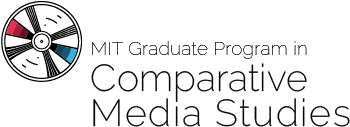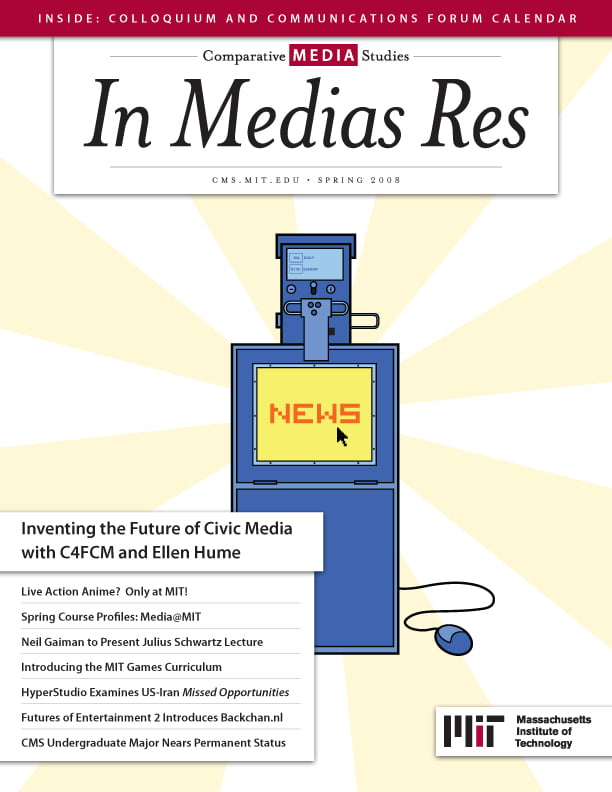

Spring semester will mark the culmination of a long struggle. Five years ago, the Committee on Undergraduate Programs (CUP) together with the Committee on Curricula (CoC) approved an experimental S.B. program in Comparative Media Studies. The award of even this tentative status was something of a hard fought victory since, until this point, no interdisciplinary majors – experimental or otherwise – had been granted. The Institute, steeped in a long-standing culture of disciplines and departments, was apprehensive about such a dramatic move. But CMS was fortunate to find support among our sponsoring sections (Foreign Languages and Literatures, Literature, and Writing and Humanistic Studies), SHASS, and across the Institute generally. Our departure from the unwritten rules was marked by a change in the name of our degree: the ‘major departure’ in CMS became simply a ‘major’. There was one hitch: we were granted a five-year license to demonstrate our program’s viability and fulfill a number of criteria.
Pinocchio comes to mind, not just because of his transmedia presence and repeated iterations in manga and anime (come to think of it, Osamu Tezuka’s Astro Boy has some interesting potentials as an analogy for CMS), but because, cobbled together from unruly pieces of wood, and balancing poverty and resourcefulness, he was driven by a desire to become a real boy. The CMS undergraduate program, too, has been pulled together from sometimes disparate bits, and has had its share of balancing acts, all with the goal of becoming a real major. However, Pinocchio provides an analogy that one would not want to press too far (we are certainly irrepressible and adventurous, but not even CMS’s critics would be able to do much with the storylines about the donkey and the long nose). We are now at an important juncture where, five years later, having just been reviewed and unanimously supported by the CUP and CoC, we are about to face the Faculty Policy Committee and the Faculty for final approval as a real major. Stay tuned.
The past few years have seen a distinct climate change at MIT. The Task Force on the Undergraduate Educational Commons [2006] observed that many MIT students “increasingly seek to explore professional paths that do not neatly map onto the traditional disciplines and major programs that have long been offered.” And recent discussions of ways to reinvigorate the undergraduate curriculum have increasingly turned to the kinds of cross-disciplinary, trans-disciplinary and even multi-disciplinary approaches to education that characterize both the CMS undergraduate and graduate programs. Collaborative and cross-disciplinary to the core, CMS can respond quickly to the dynamic reconfigurations of the professional, educational and commercial media landscape, creatively deploying resources that are normally dispersed across the institute. The videogame curriculum that we have been developing stands as an example of this responsiveness, a move attested to by the pool of students who have selected a joint engineering and humanities major in CMS.
A group of 25 CMS faculty met last semester to redesign the mid-tier of the major, currently occupied by CMS.400. In its place, majors will have a choice of four new courses that embody the core principles of CMS. Entitled Media and Methods, the courses thematically address hearing, performing, reading and seeing – across media, across cultures, and across time. The first of these courses will be offered next year by Jay Scheib (Music and Theater Arts), who will explore performance in such spaces as environmental theater, live audio tours, and everyday life; and next Spring, Glorianna Davenport (Media Lab) will teach a course on seeing and expression, examining photography, sculpture, interactive media and visual approaches to narrative. These courses and those to follow the year after, both in their cross-disciplinary construction and their intent, reflect the strengths of this major departure from disciplinarity as usual. Together with the organization of thematically coherent course clusters parallel to the videogame curriculum, the ‘new’ CMS major demonstrates the potential of this innovative approach at a moment of rapid media change.
Add to this mix the opportunities afforded by the graduate CMS program, the research projects (this semester, for example, GAMBIT alone is employing 25 UROPs), the visiting scholars program, and the weekly colloquium and Communications Forum events, and the steady growth of the CMS major comes as no surprise. We are now the largest major in the humanities, and as our graduates accrete, we are building an increasingly compelling alumni network. This issue of In Medias Res offers updates on these various activities, and we plan to feature more of our undergraduates in the pages of our next issue.
Before closing, we wish to extend a warm welcome to Doris Rusch, a GAMBIT postdoctoral associate; Esteve Ollé, a postdoctoral fellow affiliated with C3; Marleigh Norton, GAMBIT project manager; and Ellen Hume, who has joined us as Research Director of The Center for Future Civic Media, a collaborative effort between CMS and the Media Lab. Their profiles can be found in this issue of IMR, starting with Ellen’s, if you’ll turn the page…



